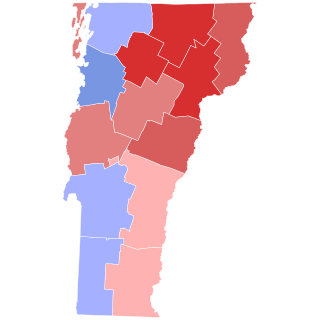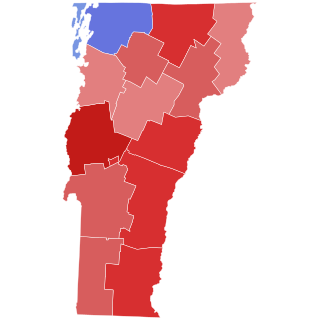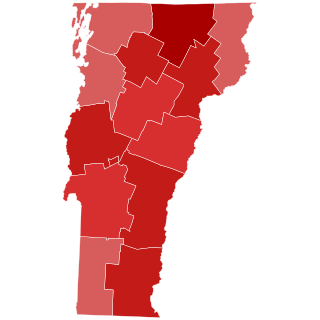
The 1932 United States Senate election in Vermont took place on November 8, 1932. Republican Porter H. Dale successfully ran for re-election to another term in the United States Senate, defeating Democratic candidate Fred C. Martin. Dale died in October 1933, vacating the seat until a special election was held in January 1934.

The 1952 Vermont gubernatorial election took place on November 4, 1952. Incumbent Republican Lee E. Emerson ran successfully for re-election to a second term as Governor of Vermont, defeating Democratic candidate Robert W. Larrow and write-in candidate Henry D. Vail.

The 1946 Vermont gubernatorial election took place on November 5, 1946. Incumbent Republican Mortimer R. Proctor ran unsuccessfully for re-election to a second term as Governor of Vermont, losing to Ernest W. Gibson, Jr. in the Republican primary. Gibson defeated Democratic candidate Berthold C. Coburn in the general election.

The 1944 Vermont gubernatorial election took place on November 7, 1944. Incumbent Republican William H. Wills did not run for re-election to a third term as Governor of Vermont. Republican candidate Mortimer R. Proctor defeated Democratic candidate Ernest H. Bailey to succeed him.

The 1942 Vermont gubernatorial election took place on November 3, 1942. Incumbent Republican William H. Wills ran successfully for re-election to a second term as Governor of Vermont, defeating Democratic candidate Park H. Pollard.

The 1940 Vermont gubernatorial election took place on November 5, 1940. Incumbent Republican George Aiken did not run for re-election to a third term as Governor of Vermont, instead running for the United States Senate. Republican candidate William H. Wills defeated Democratic candidate John McGrath to succeed him.

The 1938 Vermont gubernatorial election took place on November 8, 1938. Incumbent Republican George Aiken ran successfully for re-election to a second term as Governor of Vermont, defeating Democratic candidate Fred C. Martin.

The 1936 Vermont gubernatorial election took place on November 3, 1936. Incumbent Republican Charles M. Smith did not run for re-election to a second term as Governor of Vermont. Republican candidate George Aiken defeated Democratic candidate Alfred H. Heininger to succeed him.

The 1934 Vermont gubernatorial election took place on November 6, 1934. Incumbent Republican Stanley C. Wilson did not run for re-election to a third term as Governor of Vermont. Republican candidate Charles M. Smith defeated Democratic candidate James P. Leamy to succeed him.

The 1930 Vermont gubernatorial election took place on November 4, 1930. Incumbent Republican John E. Weeks did not run for re-election to a third term as Governor of Vermont. Republican candidate Stanley C. Wilson defeated Democratic candidate Park H. Pollard to succeed him.

The 1928 Vermont gubernatorial election took place on November 6, 1928. Incumbent Republican John E. Weeks ran successfully for re-election to a second term as Governor of Vermont, defeating Democratic candidate Harry C. Shurtleff, an attorney. Weeks, who sought an exception to the Vermont Republican Party's "Mountain Rule", was the first Vermont Governor elected to a second two-year term.

The 1926 Vermont gubernatorial election took place on November 2, 1926. Incumbent Republican Franklin S. Billings, per the "Mountain Rule", did not run for re-election to a second term as Governor of Vermont. Republican candidate John E. Weeks defeated Democratic candidate Herbert C. Comings to succeed him.

The 1924 Vermont gubernatorial election took place on November 4, 1924. Incumbent Republican Redfield Proctor Jr., per the "Mountain Rule", did not run for re-election to a second term as Governor of Vermont. Republican candidate Franklin S. Billings defeated Democratic candidate Fred C. Martin to succeed him.

The 1922 Vermont gubernatorial election took place on November 7, 1922. Incumbent Republican James Hartness, per the "Mountain Rule", did not run for re-election to a second term as Governor of Vermont. Republican candidate Redfield Proctor Jr. defeated Democratic candidate John Holmes Jackson to succeed him.

The 1920 Vermont gubernatorial election took place on November 2, 1920. Incumbent Republican Percival W. Clement, per the "Mountain Rule", did not run for re-election to a second term as Governor of Vermont. Republican candidate James Hartness defeated Democratic candidate Fred C. Martin to succeed him.

The 1918 Vermont gubernatorial election took place on November 5, 1918. Incumbent Republican Horace F. Graham, per the "Mountain Rule", did not run for re-election to a second term as Governor of Vermont. Republican candidate Percival W. Clement defeated Democratic candidate William B. Mayo to succeed him.

The 1916 Vermont gubernatorial election took place on November 7, 1916. Incumbent Republican Charles W. Gates, per the "Mountain Rule", did not run for re-election to a second term as Governor of Vermont. Republican candidate Horace F. Graham defeated Democratic candidate William B. Mayo to succeed him.

The 1914 Vermont gubernatorial election took place on November 3, 1914. Incumbent Republican Allen M. Fletcher, per the "Mountain Rule", did not run for re-election to a second term as Governor of Vermont. Republican candidate Charles W. Gates defeated Democratic candidate Harland B. Howe and Progressive candidate Walter J. Aldrich to succeed him.

The 1908 Vermont gubernatorial election took place on September 1, 1908. Incumbent Republican Fletcher D. Proctor, per the "Mountain Rule", did not run for re-election to a second term as Governor of Vermont. Republican candidate George H. Prouty defeated Democratic candidate, Burlington mayor James Edmund Burke to succeed him.

The 1946 United States Senate election in Vermont took place on November 5, 1946. Incumbent Republican Ralph Flanders successfully ran for re-election to a full term in the United States Senate, defeating Democratic candidate Charles P. McDevitt.






















